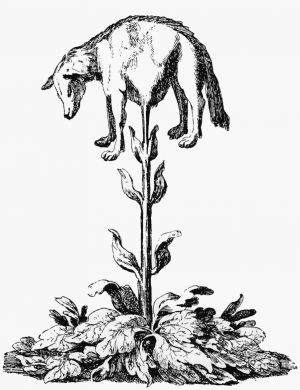
The Borometz ('Agnus scythicus' or 'Planta Tartarica Barometz' or 'Vegetable Lamb of Tartary') is a legendary hybrid plant of central Asia, believed to grow sheep as its fruit.
Nature
Etymology
The tale of the Vegetable Lamb of Tartary comes from the Middle Ages, a traveler's tale from the Far East. It's full name was 'Planta Tartarica Barometz' - 'barometz' is the Tartar word for 'lamb'. It was known under various other names including the Scythian Lamb, the Borometz, Barometz and the Borametz.
Description/Morphology
This "lamb-plant" is represented as springing from a seed like that of a melon, but rounder, and supposedly cultivated by natives of the country where it grew. The lamb was contained within the fruit or seedcapsule of the plant, which would burst open when ripe to reveal the little lamb within it. The wool of this little lamb was described as being "very white." Once hatched these creatures could only attain maturity if their umbilical "stem" remained attached to its mother tree. During the course of its restrained existence, the Barbary Lamb would consume any and all vegetation within its limited reach, once its food sources were depleted however, the animal would soon perish. Reportedly a favorite food of wolves as well as humans, the Barbary Lamb's flesh was purported to taste like fish and its blood was likened to honey.
History/Beliefs
- Heroditus mentions the Borametz as early as 442 B.C. Theophrastus (306 B.C.), the disciple of Aristotle, had earlier described wool-bearing trees with a pod the size of a spring apple, leaves like those of the black mulberry, but the whole plant resembled the dog-rose. Pliny the Elder (77 A.D.) also mentioned "wool-bearing trees," but seemed to confuse cotton and flax in his writings.
- In 1235 it is stated in the Jerusalem Talmud that is a human being of the mountains: "it lives by means of its navel: if its navel be cut, it cannot live. ...this is the animal called Jeduah."
- This is also the Jedoui mentioned in the Christian Bible in the book of Leviticus (xix, 31). Called Jedua, this animal is human in all respects, except that by its navel it is joined to the stem that issues from the root. No creature can approach within the tether for it seizes and kills them. Within the tether of the stem, it devours the herbage all around it. To kill it, men must tear at it or aim arrows at its stem until it is ruptured, whereupon the animal dies.4 It is little wonder then that medieval thinkers strongly believed in and hotly debated the existence of such things as the mysterious plant animals embodied in the myth of "the Lamb of Tartary" (Fig. 1) and in other myths of that time.
- Sir John Mandeville, the 14th century author, adventurer and English knight, who returned to Great Briton after a 34-year odyssey, claims to have encountered numerous strange beasts, including the Barbary Lamb:
- "There groweth a manner of fruit as it were gourds, and when it is ripe men cut it a sonder, and men fynde therein a beast as it were of flesh and bone and blood, as it were a lyttle lambe without wolle, and men eat the beast and fruit also, and sure it seemeth very strange."
- A plant called Borometz is mentioned in Chapter 22 of Simplicius Simplicissimus, a picaresque novel by Hans Jakob Christoffel von Grimmelshausen, when the protagonist describes his abduction by Tartars.
- Sigismund, Baron von Herberstein, who in 1517 and 1526 was the Ambassador to the Emperors Maximilian I and Charles V and to the "Grand Czard or Duke of Muscovy," spoke for many of his time when he said in his "Notes on Russia" (Rerum Muscoviticarum Commentarii, 1549) of the "Vegetable lamb":
It had a head, yes, ears, and all other parts a newly born lamb.
...For myself, although I had previously regarded these Borametz
as fabulous, the accounts of it were confirmed to me by so many
persons of credence that I thought it right to describe it.
- John Parkinson (1656) figured the lamb-plant in the frontispiece of his Paridisi in Sole--in the center just to the left is a tiny Borametz. A more detailed report comes to us from Claude Douret in 1605. In one of the chapters of his seminal botanical text, the "Historie Admirable des Plantes", this early scientist discusses the history and biology of these creatures, as well as its primitive fortean attributes:
"A zoophyte, or plant animal, called in the Hebrew Jeduah.
It was in form like a lamb, and from its navel, grew
a stem or root by which this Zoophyte, or plant-animal,
was fixed attached, like a gourd to the soil below the surface
of the ground, and, according to the length of its stem or root,
it devoured all the herbage which it was able to reach
within the circle of its tether. The hunters who went in
search of this creature were unable to capture, or remove it,
until they had succeeded in cutting the stem by well-aimed arrows, or darts,
when the animal immediately fell prostrate
to the earth, and died. Its bones being placed with certain ceremonies
and incantations in the mouth of one desiring
to foretell the future, he was instantly seized with a gift of divination,
and endowed with the gift of prophesy."
- Toward the end of the 18th century, eminent botanists, who were well acquainted with the specimens described earlier by Sloane, Breyn, and others, again made the legendary Borametz their theme. This time it was also picked up by the literary men of the time. In 1781, Dr. Erasmus Darwin made it the subject of his poem, The Botanic Garden (London, 1781):
E'en round the Pole the flames of love aspire,
And icy bosoms feel the secret fire,
Cradled in snow, and fanned by Arctic air,
Shines, gentle borametz, thy golden hair;
Rooted in earth, each cloven foot descends,
And round and round her flexile neck she bends,
Crops the grey coral moss, and hoary thyme,
Or laps with rosy tongue the melting rime;
Eyes with mute tenderness her distant dam,
And seems to bleat - a vegetable lamb.
- Later, in 1791, Dr. De la Croix, in his Connubia Florum, Latino Carmine Demonstrata (Bath, 1791), extolled the fabulous plantanimal in a Latin poem, which critics at the time hailed as approaching the quality of Virgil's "Georgics." The poem says, in part (translated):
For in his path he sees a monstrous birth,
The Borametz arises from the earth
Upon a stalk is fixed a living brute,
A rooted plant bears quadruped for fruit,
...It is an animal that sleeps by day
and wakes at night, though rooted in the ground,
to feed on grass within its reach around.6
Theories and analysis
Skeptics have pointed out that accounts of the Barbary Lamb most likely extend from eyewitness reports of large cotton plants, which in the Middle Ages was an unheard of sight for European explorers. They reasoned that the material was wool - a fabric they did know. The figured that since wool came from sheep, and that the plant was some kind of animal/plant. They thought that the puffs of cotton were tiny sheep attached to the plant by their navel.
A real plant is calledCibotium barometz and is a fern of the genus Cibotium. It was known under various other names including the Scythian Lamb, the Borometz, Barometz and the Borametz.
Popular culture
In the PlayStation 2 game Odin Sphere, Baromett seeds can be planted and grow to be plants that bear two sheep.
Sources
- Legend of the Lamb-Plant
- Note to Sir Thomas Browne, Pseudodoxia Epidemica, III.28

